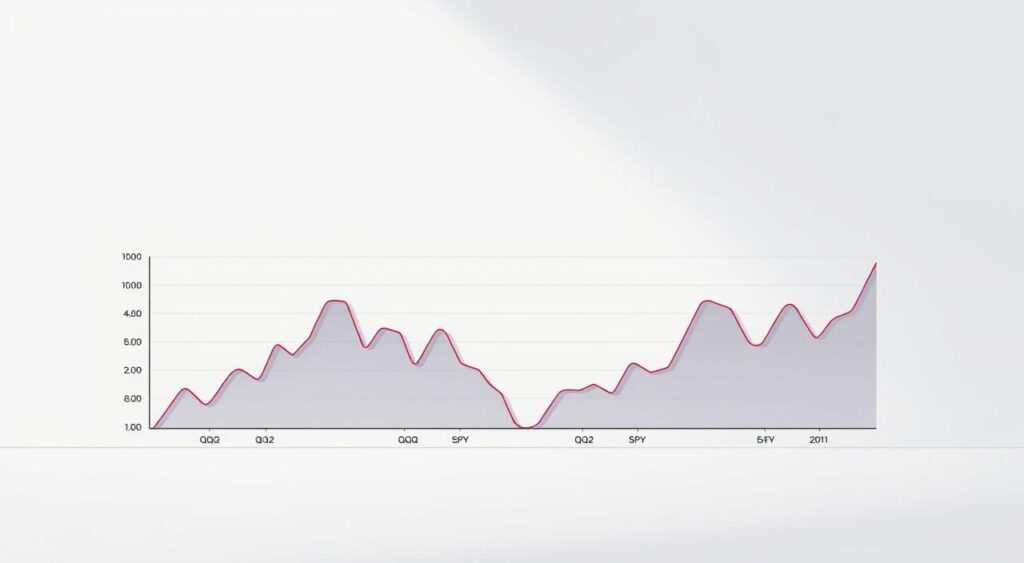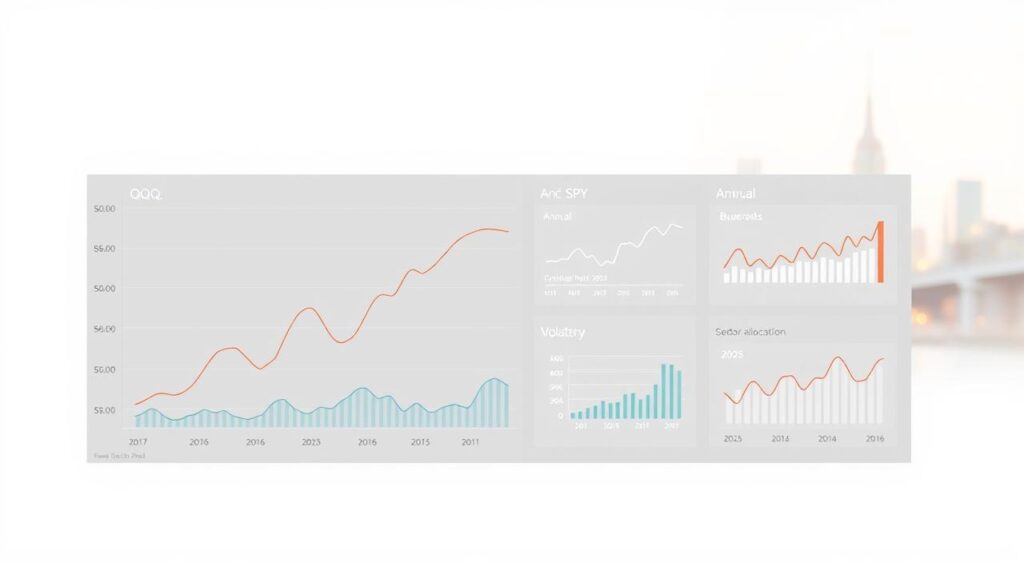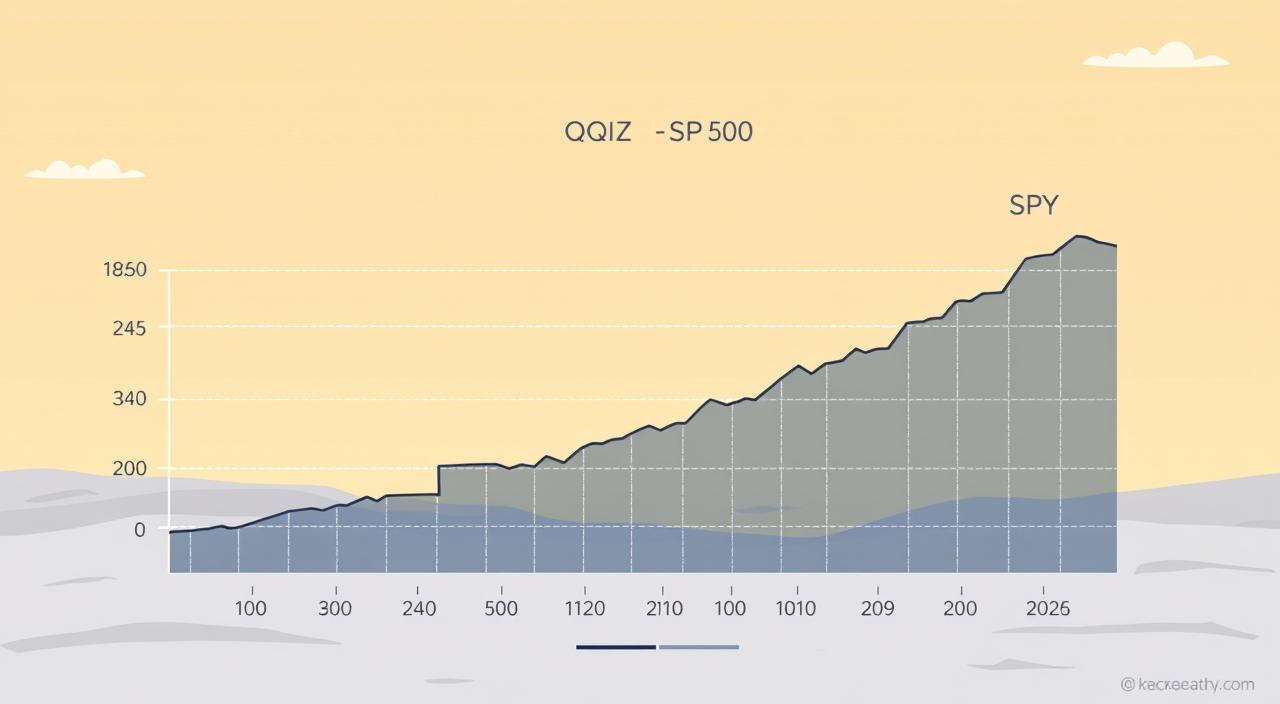QQQ vs SPY: Which ETF Performs Better in 2025?
As we look ahead to 2025, the debate over QQQ vs SPY takes center stage in the investment community. Both ETFs have proven to be popular choices among investors, but discerning which ETF performs better in 2025 requires an in-depth understanding of their historical performance, current market trends, and future projections. This comparison will explore vital factors such as risks, returns, and suitability for various investment strategies, equipping investors with the insights they need to make informed decisions. With the upcoming economic landscape in mind, let’s delve into the details that shape the best ETF 2025 for your financial goals.
Key Takeaways
- Understanding the QQQ vs SPY debate is essential for informed investing.
- Both ETFs have distinct performance dynamics that suit different strategies.
- Analyzing historical data is vital for forecasting future ETF performance in 2025.
- Investor goals should dictate the choice between QQQ and SPY.
- Market trends and economic indicators will shape ETF performance in the coming years.
Overview of QQQ and SPY ETFs
Understanding the key features of the QQQ and SPY ETFs offers valuable insights for investors seeking to navigate their options. Both funds cater to different investment strategies and sectors, leading to a compelling comparison QQQ SPY. Here is a breakdown of each ETF and their distinctive traits.
What is QQQ?
The Invesco QQQ Trust, established in 1999, aims to track the Nasdaq-100 Index. This fund emphasizes the performance of the 100 largest non-financial companies listed on the Nasdaq stock exchange. Investors appreciate its relatively low expense ratio of 0.20%, making it an attractive option for those keen on technology and growth sectors. As of July 1, 2025, QQQ is priced at USD 551.64 with a year-to-date return of +7.54%.
What is SPY?
The SPDR S&P 500 ETF Trust, commonly known as SPY, serves as a benchmark for investors looking to track the performance of the S&P 500 Index. Launched in 1993, this ETF comprises 500 of the largest U.S. companies, offering a broader market exposure compared to QQQ. The expense ratio for SPY is approximately 0.09%, making it one of the most cost-effective ETF choices for investors seeking diversification.
Key Differences Between QQQ and SPY
The ETF investment comparison between QQQ and SPY reveals essential differences that investors should consider:
- Focus: QQQ emphasizes tech and growth stocks, while SPY covers a wider range of sectors.
- Expense Ratio: QQQ has a higher expense ratio compared to SPY.
- Performance Metrics: Each ETF showcases varied historical returns, influenced by sector performance.
Historical Performance Analysis
Investors often examine historical performance to gauge future potential. In the evaluation of ETF returns QQQ vs SPY, several trends emerge that warrant attention. Understanding these historical returns equips investors with valuable insights to navigate their choices effectively in a competitive market.
Reviewing QQQ’s Historical Returns
QQQ has established an impressive track record over the past decade. The fund boasts an annualized return of 17.81%. This figure significantly outpaces SPY’s annualized return of 12.77%. Such strong historical performance suggests that QQQ might be a compelling choice for those looking at the top ETF 2025 forecasts. The significant one-year gain of 31.25% observed in 2024-2025 further reinforces this perspective, highlighting QQQ’s ability to capitalize on market opportunities.
Reviewing SPY’s Historical Returns
In contrast, SPY has maintained respectable performance over the years, albeit at a lower rate compared to QQQ. Its annualized return of 12.77% reflects the broader market trends influenced by a variety of sectors and economic conditions. For many investors, SPY offers a diversified portfolio with exposure to the overall market, appealing to those who prefer a more stable investment approach.
Trends in Market Performance
Analyzing historical performance reveals valuable trends in market dynamics. Investors should be aware of how QQQ’s concentration on technology stocks can lead to volatile swings in comparison to SPY’s broader market representation. This performance analysis highlights the importance of strategy when considering long-term investments. Future ETF returns for QQQ and SPY may reflect overarching economic factors as well as sector-specific trends.

Factors Influencing ETF Performance in 2025
Understanding the dynamics affecting ETF performance becomes essential when examining the QQQ vs SPY 2025 trends. Various economic indicators and industry influences play crucial roles in shaping these performance metrics. Investors should pay attention to several key elements.
Economic Indicators to Watch
Economic indicators, such as inflation rates, employment statistics, and GDP growth, will have a significant impact on market conditions. These factors influence investor sentiment and can affect QQQ and SPY differently based on their composition. For instance, a rise in inflation might lead to a shift in investment strategies. Investors interested in learning more about the interplay between these indicators and ETF dynamics can explore various resources to enhance their knowledge.
Industry Trends Impacting QQQ and SPY
Industry influences on ETFs are another critical factor. The technology sector, prominently represented in QQQ, tends to react differently to economic shifts compared to the diversified holdings of SPY. As industries evolve and adapt, tracking these trends provides a clearer picture of potential ETF performance in the upcoming years. Specific industries, such as renewable energy and tech, are expected to represent substantial growth areas.
Federal Reserve Policy Effects
The Federal Reserve’s monetary policies can create waves in the financial markets, influencing both QQQ and SPY significantly. Changes in interest rates directly affect borrowing costs and investment strategies across industries. Analysts suggest that monitoring the Federal Reserve’s actions will be crucial for investors aiming to navigate potential volatility in the ETFs
Analyst Predictions for QQQ and SPY in 2025
As investors prepare for the future, a thorough examination of financial analyst predictions becomes essential. This analysis sheds light on anticipated trends regarding QQQ and SPY, focusing on their expected performance in 2025. The insights provided by experts can significantly aid investors in making informed decisions as they look ahead.
Expert Forecasts on QQQ
The outlook for QQQ remains optimistic among many financial analysts. Continued growth is highly expected due to the robust performance of technology companies within the ETF. Analysts foresee that advancements in areas such as artificial intelligence, cloud computing, and cybersecurity will be pivotal in driving returns. With the tech sector dominating market trends, many are predicting performance returns that exceed those seen in previous years, reinforcing confidence in QQQ as a compelling investment choice.
Expert Forecasts on SPY
In the arena of SPY, analysts offer a varied perspective. The ETF, which reflects the broader market, is anticipated to experience growth fueled by economic recovery and steadier financial conditions. Predictions indicate that diversified holdings may provide a cushion against market volatility. Analysts emphasize that sectors like consumer discretionary and healthcare could lift SPY’s performance as markets adjust to evolving consumer demands and technological advancements.
Poll of Financial Analysts
A recent poll of financial analysts reveals a split outlook on QQQ vs SPY analysis. While many support QQQ’s potential for explosive growth, others advocate for SPY’s steadier trajectory. Analyst opinions suggest a preference for both ETFs depending on the investor’s risk tolerance and market outlook. ETF performance forecasts indicate that those seeking bold growth may lean towards QQQ, whereas investors valuing stability might opt for SPY.

Risk Assessment of Investing in QQQ and SPY
Investing in QQQ and SPY presents a range of risk factors that potential investors should carefully evaluate. Both funds offer unique performance profiles, influenced by various elements including market volatility and sector-specific risks.
Volatility and Market Risks
When assessing the risk assessment QQQ SPY, one must consider the inherent ETF volatility. QQQ often demonstrates a higher degree of volatility due to its concentration in technology stocks. This volatility can lead to significant price swings in short periods, which, while providing opportunities for profit, can also pose challenges for risk-averse investors.
Sector-Specific Risks for QQQ
QQQ’s heavy reliance on the technology sector introduces unique market risks investing. Should there be downturns or regulatory changes affecting tech companies, QQQ investors may face substantial losses. Recognizing the dependencies on a limited number of stocks is crucial for understanding the full spectrum of risks associated with QQQ.
Broader Market Risks for SPY
SPY, tracking the S&P 500, deals with broader market risks that can impact a wide range of sectors. Economic fluctuations, interest rate changes, and geopolitical events can significantly affect SPY’s performance. Investors must stay informed about these external factors as they can lead to shifts in market sentiment, driving SPY’s price movement.
Conclusion: Which ETF is the Better Investment?
After examining the intricacies of QQQ and SPY, it’s evident that both ETFs serve distinct roles in investment strategies. QQQ, heavily weighted in technology stocks, is ideal for those looking to capitalize on growth-oriented sectors, while SPY provides exposure to a broader market with a focus on stability. Understanding these differences is crucial for making informed investment decisions.
Summary of Key Findings
The analysis shows that QQQ has historically outperformed SPY during tech booms, primarily due to its concentration in high-growth companies. Conversely, SPY often provides more consistent returns during market downturns, making it less volatile. These factors highlight the importance of aligning your investment strategy with your financial goals when considering the best ETF 2025.
Final Thoughts on QQQ vs SPY
In the wrap-up of the QQQ vs SPY discussion, it’s essential to recognize the unique benefits each fund offers. If high growth potential excites you, QQQ might be the right fit, but if stability is your priority, SPY could be the stronger choice. Your decision should be reflective of both your risk tolerance and investment horizon.
Recommendations for Investors
For discerning investors looking to optimize their portfolios, both QQQ and SPY offer valuable opportunities. Diversifying with both ETFs could enhance risk management while tapping into the strengths of each. As you navigate your QQQ vs SPY investment decisions, remain flexible and informed to make the best possible choices for your financial future.






